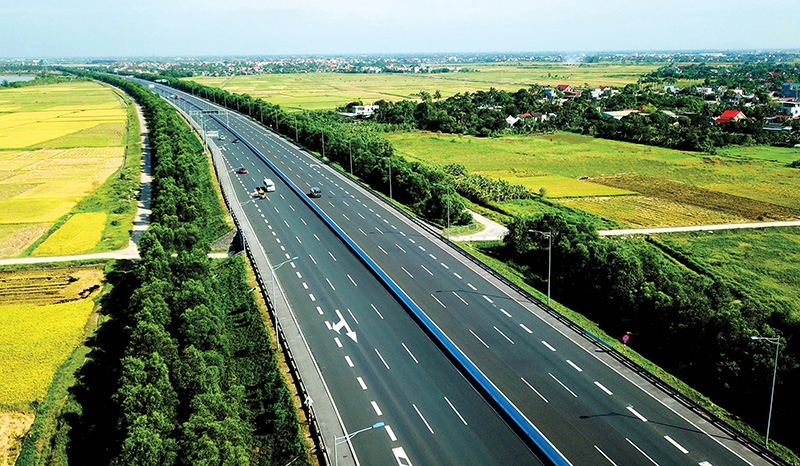Shake-up required to fund infrastructure
 |
| Shake-up required to fund infrastructure |
The National Assembly (NA) last week adopted a hallmark resolution on the 2021-2025 medium-term public investment plan, in which the total money for investment from the state budget will be at least VND2.87 quadrillion ($124.8 billion). This includes VND1.5 quadrillion ($65.2 billion) from the central coffers - including VND1.2 quadrillion ($52.17 billion) from the domestic capital and the rest from foreign sources – and VND1.37 quadrillion ($59.56 billion) from localities’ budget.
The 2021-2025 plan will be deployed under priorities, with the total number of projects so far at nearly 5,000, down over half as compared to that in 2016-2020. The number of new projects will be nearly 2,240. The average capital for each project will be VND210.4 billion ($9.14 million), which is 2.4 times higher than that in the previous period.
However, many NA deputies said that such state funding until 2025 will not be sufficient for Vietnam to remarkably change its infrastructure landscape, which remains a big barrier for the country’s socioeconomic development.
“The VND2.87 quadrillion ($124.8 billion) as public investment is not so much amid huge demands for development funding. Thus we need to stress that public investment like this is just a primer for wooing private investment. Especially, we must boost public-private partnerships (PPPs), with attractive mechanisms for private investors,” said deputy Hoang Van Cuong, representing Hanoi.
“We have learned valuable lessons from some very successful PPP projects like Halong–Van Don Expressway and Van Don Airport in the northeastern province of Quang Ninh,” Cuong said. “These projects are testimony to our success in calling for good investors and we must seek resources for development.”
Built under the build-operate-transfer format, the 60km Halong–Van Don Expressway has a maximum speed of 100km per hour and cuts travel time between Halong and Van Don by half, to only 50 minutes. With the investor being Sun Group, the project was valued at VND12 trillion ($521.74 million), built during 2015-2018 before it was officially put into operation in February 2019.
“The investment format of this project needs to be multiplied nationwide. If our projects are not really attractive, we must design independent projects with all obstructions removed to attract private investors,” Cuong added.
NA deputy Nguyen Tao, representing the Central Highlands province of Lam Dong, also cited a conclusion by the prime minister at a recent meeting with localities that the medium-term public investment capital is a primer for Vietnam to attract private investors and create a breakthrough to implement the government’s programme on constructing 5,000km of expressways by 2026.
“This year is the first for us to implement the Law on Public-Private Partnership Investment, and the government has demonstrated its high determination in attracting investment via strongly institutional reform and removal of difficulties in implementing this law,” Tao said.
He cited Lam Dong and the southern province of Dong Nai having actively implemented the law since early this year, with the upcoming deployment of the 67km Tan Phu-Bao Loc Expressway under the PPP format, valued at over VND18 trillion ($782.6 million). The four-lane project belongs to Dau Giay-Lien Khuong Expressway, with the investor reported to be a partnership between Deo Ca Group and Hung Thinh.
“In June, the National Appraisal Council and authorities of Lam Dong and Dong Nai made a pre-feasibility report for the project, and the report will be submitted to the prime minister for approval for PPP implementation,” Tao said.
Also highlighting the role of private investment in infrastructure, deputy Thach Phuoc Binh representing the Mekong Delta province of Tra Vinh said that in 2016-2020, the rate of public investment disbursement hit 80.3, 73.3, 66.8, 67.4, and 63.8 per cent of the plan, respectively. “Currently, private investors are not so much interested in long-term infrastructure projects. It is due to risks caused by the frequent adjustment in the country’s law system,” Binh said. “It is high time investment was assessed based on effectiveness, not on the obedience of regulations. PPP is a good tool for attracting private investment, but the government needs to offer attractive mechanisms for private investors.”
Don Lambert, principal private sector development specialist at the Asian Development Bank, told VIR that the spending required to close the infrastructure gap in Vietnam is significant.
“By 2030 at the latest, Vietnam will need an estimated $237 billion for infrastructure investments to achieve its Sustainable Development Goals. To fund this, the Global Infrastructure Hub estimates that Vietnam will need to mobilise $49 billion above what it has historically spent,” Lambert said.
The government already shoulders 90 per cent of infrastructure spending, and public investment as a proportion of GDP at 8 per cent is relatively high. “Therefore, Vietnam cannot afford a large increase in its infrastructure budget, given the fiscal pressures the pandemic introduced. PPPs could help to address the shortfall,” Lambert continued.
What the stars mean:
★ Poor ★ ★ Promising ★★★ Good ★★★★ Very good ★★★★★ Exceptional
Related Contents
Latest News
More News
- Government moves to establish International Financial Centre (December 21, 2025 | 21:00)
- Vietnam's IFC to target global investment flows (December 21, 2025 | 18:00)
- Two national hospitals expand capacity with new facilities (December 20, 2025 | 09:00)
- Ha Tinh breaks ground on major Vingroup industrial and energy projects (December 19, 2025 | 18:24)
- EVN launches major power infrastructure projects nationwide (December 19, 2025 | 18:17)
- VAL inaugurates second production line to meet domestic animal feed demand (December 19, 2025 | 16:37)
- Sun Group pioneers urban tram system in Phu Quoc (December 19, 2025 | 15:00)
- Seven major projects launched to drive Hanoi’s next growth phase (December 19, 2025 | 14:00)
- Securing capital and efficiency for Vietnam’s 2026-2030 growth ambitions (December 17, 2025 | 10:00)
- Vietnam bucking trend in the global M&A landscape (December 16, 2025 | 14:20)

 Tag:
Tag:




















 Mobile Version
Mobile Version